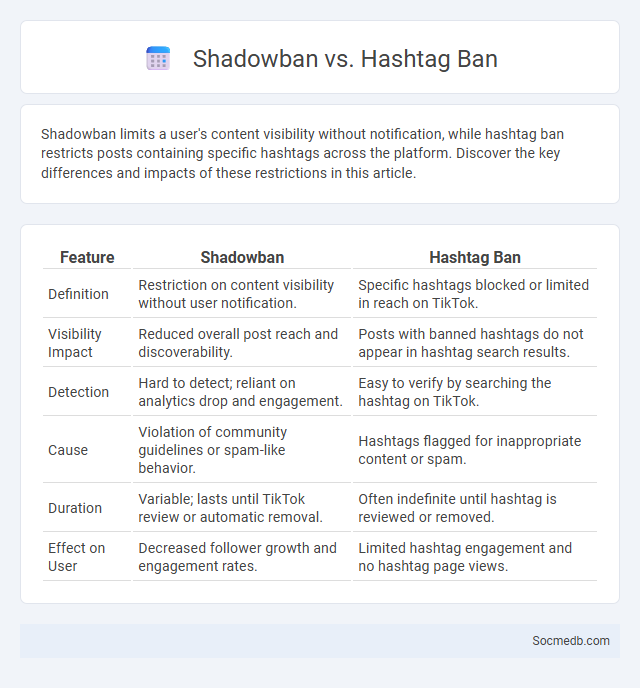
Photo illustration: Shadowban vs Hashtag Ban
Shadowban limits a user's content visibility without notification, while hashtag ban restricts posts containing specific hashtags across the platform. Discover the key differences and impacts of these restrictions in this article.
Table of Comparison
| Feature | Shadowban | Hashtag Ban |
|---|---|---|
| Definition | Restriction on content visibility without user notification. | Specific hashtags blocked or limited in reach on TikTok. |
| Visibility Impact | Reduced overall post reach and discoverability. | Posts with banned hashtags do not appear in hashtag search results. |
| Detection | Hard to detect; reliant on analytics drop and engagement. | Easy to verify by searching the hashtag on TikTok. |
| Cause | Violation of community guidelines or spam-like behavior. | Hashtags flagged for inappropriate content or spam. |
| Duration | Variable; lasts until TikTok review or automatic removal. | Often indefinite until hashtag is reviewed or removed. |
| Effect on User | Decreased follower growth and engagement rates. | Limited hashtag engagement and no hashtag page views. |
Understanding Shadowban: Definition and Impact
Shadowban is a hidden restriction imposed by social media platforms that limits the visibility of your content without notifying you. This moderation technique prevents your posts from appearing in hashtags or feed algorithms, reducing engagement and reach significantly. Recognizing the signs of a shadowban is crucial for maintaining your account's influence and restoring your social media presence.
What is a Hashtag Ban?
A hashtag ban refers to the removal or restriction of specific hashtags on social media platforms to prevent their use in posts, often due to inappropriate content or misinformation associated with them. This practice limits your ability to reach audiences who search or follow these banned hashtags, impacting content visibility and engagement. Platforms implement hashtag bans to maintain community standards and reduce the spread of harmful or misleading information.
Shadowbanning Explained: How It Works
Shadowbanning is a covert method used by social media platforms to limit the visibility of a user's content without their knowledge, often by restricting distribution in feeds or search results. This practice targets accounts that violate community guidelines or engage in spammy behavior, effectively reducing your reach while keeping the account active. Understanding shadowbanning helps you identify sudden drops in engagement and adjust your content strategy accordingly to maintain visibility.
Key Differences: Shadowban vs Hashtag Ban
Shadowban restricts the visibility of your social media content without notifying you, often by limiting your posts from appearing in feeds or searches broadly. Hashtag ban specifically blocks content from being seen under particular hashtags due to violations or low-quality tagging, impacting discoverability through those tags alone. Understanding these differences helps you adjust your strategy to maintain your audience reach effectively.
Signs You’ve Been Shadowbanned
Shadowbanning on social media can silently reduce Your post visibility, drastically limiting engagement without notification. Signs you've been shadowbanned include a sudden drop in interaction, posts not appearing in hashtag searches, and friends being unable to see your content on their feeds. Monitoring follower activity and using third-party tools can help confirm if a shadowban is affecting Your account.
Causes of a Hashtag Ban
Hashtag bans on social media often result from violations of platform policies, including the promotion of hate speech, misinformation, or harmful content. Algorithms detect sudden spikes in usage linked to coordinated spam, manipulation, or bot activity, triggering restrictions to maintain community standards. Enforcement actions also stem from reports by users flagging content that breaches guidelines, prompting temporary or permanent hashtag suppression.
How Platforms Enforce Shadowbanning
Social media platforms enforce shadowbanning by using automated algorithms to detect and limit the visibility of content that violates community guidelines or exhibits spam-like behavior, often without notifying the user. Machine learning models analyze user activity patterns, keyword usage, and engagement metrics to identify accounts that may be spreading misinformation, hate speech, or other prohibited content. Understanding how shadowbanning works can help you adjust your posting strategies to maintain audience reach while complying with platform policies.
Detecting and Recovering from a Shadowban
Detecting a shadowban on social media involves noticing a sudden drop in engagement, such as fewer likes, comments, or shares, and reduced visibility in hashtags or search results. Recovery often requires auditing recent content for violations of platform guidelines, removing or editing posts that may have triggered the ban, and temporarily reducing posting frequency. Rebuilding reach can be accelerated by engaging authentically with followers, diversifying content formats, and submitting appeals through the platform's support channels.
Preventing Shadowban and Hashtag Ban
To prevent shadowban and hashtag ban on social media, consistently use relevant and non-spammy hashtags while avoiding banned or repetitive tags. You should engage authentically with your audience by posting original content and adhering to platform guidelines to maintain visibility. Regularly review your account insights to detect any declines in reach, allowing for prompt adjustments to your hashtag strategy.
Implications for Social Media Strategy
Effective social media strategy hinges on understanding algorithm changes, user behavior trends, and platform-specific content preferences to maximize engagement and reach. Your approach should integrate data analytics to tailor content that resonates with target audiences, optimizing timing and format for each platform. Emphasizing authentic interaction and consistent brand messaging strengthens community building and drives conversion rates.
 socmedb.com
socmedb.com